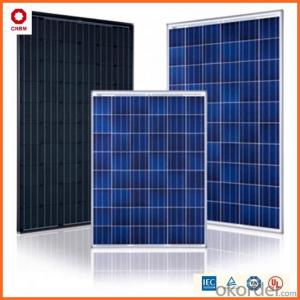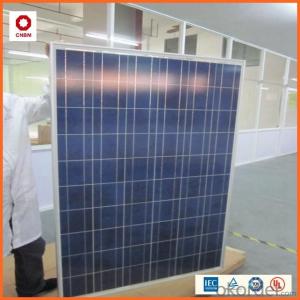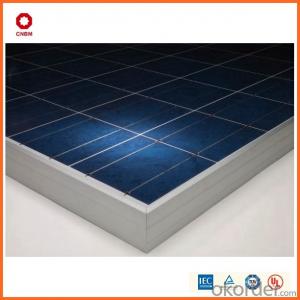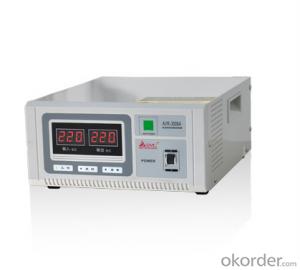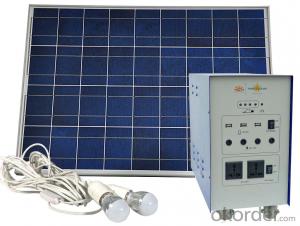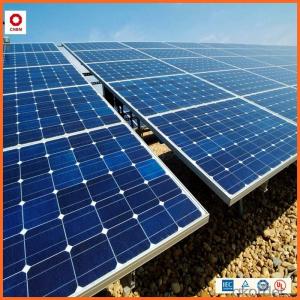70w Poly Small Solar Panels on Stock with Good Quality
- Loading Port:
- China main port
- Payment Terms:
- TT OR LC
- Min Order Qty:
- 1 watt
- Supply Capability:
- 10000000 watt/month
OKorder Service Pledge
OKorder Financial Service
You Might Also Like
Item specifice
Hot Sale !!! Quality and Safety of Small Poly Solar Panel 25~85w
1. Rigorous quality control meets the highest international standards.
2. High-transmissivity low-iron tempered glass, strong aluminium frame.
3. Using UV-resistant silicon.
4. IS09001/14001/CE/TUV/UL
Warranties of Small Poly Solar Panel 25~85w
1. 10 years limited product warranty
2. 15 years at 90% of the minimal rated power output
3. 25 years at 80% of the minimal rated power output
Specification
Characteristics of Poly solar panels CNBM (25-85W) | |||||
Max Power Voltage Vmp(V) | 30.3 | 30.8 | 31.1 | 31.4 | 31.85 |
Max Power Current Imp(A) | 7.60 | 7.64 | 7.73 | 7.81 | 7.85 |
Open Circuit Voltage Voc(V) | 36.1 | 36.6 | 37 | 37.3 | 37.68 |
Short Circuit Current Isc(A) | 8.50 | 8.55 | 8.65 | 8.75 | 8.85 |
Max Power Pm(W) | 230W | 235W | 240W | 245W | 250W |
Temperature Coefficient of Cells Poly solar panels CNBM (25-85W) | |
NOCT | 45± 2 |
Temperature Coeffucients of Isc | 0.0492 |
Temperature Coeffucients of Voc | -0.3374 |
Temperature Coeffucients of Voc | -0.4677 |
Mechanical Data of Poly solar panels CNBM (25-85W) | |
Dimension | 1638 × 982 × 40 mm |
Weight | 19.5 kg |
No. of Cells and Connections | 60 (6 ×10) |
Tolerance | 0 ~ + 5 W |
Cell | Monocrystalline Cell 156 × 156 mm |
Packing | 624 Pcs/40ft(H) Container |
Limits of Poly solar panels CNBM (25-85W) | |
Operating Temperature | -40 to +85 |
Storage Temperature | -40 to +85 |
Max System Voltage | 1000VDC(IEC) / 600VDC(UL) |
Features of our products:
• High conversion efficiency mono/poly-crystalline amorphous silicon solar cells
• Modules incorporate high performance bypass diodes to minimize the power drop caused by shading
• High transmittance, low-iron tempered glass
• High performance EVA encapsulant to prevent destroying and water.
• AI frame: without screw, corner connection. 8 holes on the frame can be installed easily
• Good performance of preventing from atrocious weather such as wind and hails
• Certifications: CE IEC TUV VDE UL, Class I
• 10 years 90% power output warranty

Shipping of Small Poly Solar Panel 25~85w
By Sea | Delivery from Shanghai or Ningbo seaport |
By Air | Departure from Shanghai Pudong Airport |
By Express | Post by DHL, EMS, UPS, TNT. |
- Q:What is the role of solar-powered water purification systems in providing clean drinking water?
- Solar-powered water purification systems play a crucial role in providing clean drinking water by harnessing the energy of the sun to remove harmful contaminants and pathogens from water sources. These systems use solar panels to generate electricity, which powers the purification process, making them environmentally friendly and cost-effective. They are especially valuable in remote or off-grid areas where access to clean water is limited. Additionally, solar-powered water purification systems are easy to maintain, making them a sustainable solution for ensuring clean and safe drinking water for communities worldwide.
- Q:Can solar energy systems be installed in areas with heavy snowfall?
- Yes, solar energy systems can be installed in areas with heavy snowfall. However, it is important to consider the impact of snow on the system's performance and take necessary precautions during installation. Snow can temporarily reduce the amount of sunlight reaching the solar panels, which in turn reduces their energy production. However, the panels are designed to have a tilt and smooth surface, allowing snow to slide off easily. Additionally, advancements in technology have led to the development of snow-resistant solar panels that are more effective at converting sunlight into electricity even in snowy conditions. It is also worth noting that solar panels are often mounted at an angle to maximize their exposure to the sun, which helps to minimize snow accumulation. Overall, while heavy snowfall may impact the efficiency of solar energy systems, they can still be successfully installed and can contribute to renewable energy generation in areas with such climatic conditions.
- Q:Can solar energy systems be used for powering electric vehicle rental services?
- Yes, solar energy systems can certainly be used for powering electric vehicle rental services. Solar panels can be installed on the roofs of rental service facilities or parking lots to generate electricity from the sun's rays. This electricity can then be used to charge the batteries of the electric vehicles, making them ready for rental at any time. By utilizing solar energy, rental services can reduce their reliance on the grid and decrease their carbon footprint. Additionally, solar-powered charging stations can be set up at various locations to provide convenient and sustainable charging options for customers. Overall, integrating solar energy systems into electric vehicle rental services not only promotes renewable energy usage but also enhances the eco-friendliness and sustainability of the transportation sector.
- Q:What is the role of solar energy systems in reducing energy inequalities?
- Solar energy systems play a crucial role in reducing energy inequalities by providing access to clean and affordable energy in remote or underprivileged areas. By harnessing the power of the sun, these systems can generate electricity, heating, and cooling without relying on traditional fossil fuels or extensive infrastructure. This empowers communities with limited resources or living in energy-poor regions to become self-sufficient and overcome energy disparities. Additionally, solar energy systems contribute to mitigating climate change, creating a more sustainable and equitable future for all.
- Q:What is the role of solar energy systems in reducing energy poverty?
- Solar energy systems play a crucial role in reducing energy poverty by providing affordable and sustainable electricity access to communities without reliable access to the grid. These systems harness the power of the sun to generate clean energy, which can be used for lighting, cooking, and powering appliances. By eliminating the need for costly and polluting fuels like kerosene, solar energy systems offer a more affordable and environmentally friendly alternative. They empower individuals and communities, improving education, healthcare, and economic opportunities, ultimately breaking the cycle of energy poverty.
- Q:How does the angle of solar panels affect their efficiency?
- The angle of solar panels greatly affects their efficiency. By adjusting the angle of the panels to match the latitude of their location, they can maximize their exposure to the sun's rays. Tilting the panels towards the sun helps to capture more sunlight throughout the day, resulting in increased energy production. A proper alignment ensures that the panels receive optimal sunlight, leading to improved efficiency and higher energy generation.
- Q:Can solar energy systems be used in powering printing presses or publishing houses?
- Yes, solar energy systems can be used to power printing presses or publishing houses. Solar energy is a renewable and sustainable source of power that can be harnessed through the use of solar panels and converted into electricity. This electricity can then be used to operate various equipment, including printing presses, computers, and other machinery commonly found in publishing houses. Installing solar panels on the rooftops of printing presses or publishing houses can generate a significant amount of electricity, reducing the reliance on traditional energy sources and lowering utility costs. The size of the solar energy system required will depend on the energy demand of the specific facility, but it is entirely feasible to power printing presses and publishing houses with solar energy. Additionally, solar energy systems can provide a reliable and consistent source of power, as long as there is sufficient sunlight available. This can be particularly beneficial in regions with abundant sunlight, as the printing presses or publishing houses can potentially become self-sufficient in terms of electricity generation. Moreover, utilizing solar energy systems for powering printing presses and publishing houses can have environmental benefits. Solar power is a clean energy source that produces no greenhouse gas emissions or air pollution during operation. By switching to solar energy, printing presses and publishing houses can significantly reduce their carbon footprint and contribute to a more sustainable future. In conclusion, solar energy systems can indeed be used to power printing presses or publishing houses. They offer a renewable, sustainable, and environmentally friendly alternative to traditional energy sources, while also providing the potential for cost savings and energy independence.
- Q:Can solar energy systems be used in powering concert halls or auditoriums?
- Certainly, concert halls and auditoriums can make use of solar energy systems to generate power. The popularity of utilizing solar energy in large venues like these has been increasing due to its various advantages. The installation of solar panels on the roof or surrounding areas of the venue allows for the capture of sunlight and its conversion into electricity. This renewable energy source can then be used to power all the electrical equipment and lighting systems within the concert hall or auditorium. One of the main benefits of incorporating solar energy systems in these venues is the potential for cost savings. Concert halls and auditoriums typically consume substantial amounts of electricity, especially during events and performances. By harnessing solar power, these venues can significantly reduce their dependence on the traditional power grid and consequently lower their energy bills. Furthermore, solar energy systems require minimal maintenance once they are installed, which further contributes to their long-term cost-effectiveness. Furthermore, the integration of solar energy into concert halls and auditoriums aligns with the global emphasis on sustainability and the reduction of carbon footprints. By utilizing renewable energy sources such as solar power, these venues can considerably decrease their greenhouse gas emissions and promote a more environmentally friendly approach to energy consumption. This not only benefits the venue itself but also contributes to the overall sustainability goals of the local community and society as a whole. However, it is important to take into account that the size and power requirements of concert halls and auditoriums may necessitate a significant investment in solar panels and related equipment. Factors such as the venue's energy demand, available installation space, and the local climate all need to be assessed during the planning stage. Ensuring that the solar energy system is appropriately sized to meet the energy needs of the venue and designed to withstand the specific weather conditions of the location is crucial. In conclusion, it is indeed possible to use solar energy systems to power concert halls or auditoriums. The advantages of employing solar power in these venues encompass cost savings, environmental sustainability, and a reduction in reliance on the traditional power grid. With careful planning and installation, solar energy can provide a reliable and efficient source of electricity to meet the energy demands of such large-scale venues.
- Q:Can solar energy systems be installed on any type of roof?
- Yes, solar energy systems can be installed on any type of roof, including flat, sloped, metal, asphalt, and tile roofs. The installation process may vary based on the roof type, but with proper planning and equipment, solar panels can be mounted securely and efficiently.
- Q:What is the role of solar energy systems in promoting social equity?
- The promotion of social equity is one of the crucial roles played by solar energy systems. These systems create equal opportunities for individuals, regardless of their socioeconomic status. Solar energy offers several benefits, with one of the key advantages being its ability to lower energy costs for households and communities. By installing solar panels, individuals can generate their own clean and renewable energy, reducing their dependence on expensive fossil fuels and traditional energy sources. The reduction in energy costs is especially significant for low-income households, who often spend a higher proportion of their income on energy bills. Solar energy systems provide them with an opportunity to decrease their energy expenses, freeing up resources that can be allocated towards other essential needs like education, healthcare, or food. By alleviating the financial burden of energy costs, solar energy promotes social equity by helping to alleviate poverty and enhancing the overall quality of life for disadvantaged communities. Furthermore, solar energy systems contribute to the creation of green jobs and economic opportunities. The installation, maintenance, and operation of solar panels require a skilled workforce, offering employment opportunities for individuals in local communities. This can particularly benefit marginalized populations who may face obstacles to employment due to limited access to education or discrimination. By providing job opportunities in the renewable energy sector, solar energy systems contribute to reducing income inequality and promoting social mobility. Solar energy also has a positive impact on the environment and public health, which is crucial for promoting social equity. Traditional energy sources, like coal or natural gas, contribute to air pollution and climate change, disproportionately affecting low-income communities and communities of color. These communities often reside near power plants or industrial areas, resulting in higher rates of respiratory diseases and other health issues. By transitioning to solar energy systems, these communities can benefit from cleaner air and reduced pollution, leading to improved public health outcomes and a more equitable distribution of environmental benefits. Solar energy promotes social equity by addressing environmental injustices and ensuring that all individuals have equal access to clean and healthy environments. In conclusion, solar energy systems play a vital role in promoting social equity by reducing energy costs, creating job opportunities, improving public health, and addressing environmental injustices. By providing equal access to clean and affordable energy, solar power helps level the playing field and ensures that all individuals, regardless of their socioeconomic status, can enjoy the advantages of renewable energy.
1. Manufacturer Overview |
|
|---|---|
| Location | |
| Year Established | |
| Annual Output Value | |
| Main Markets | |
| Company Certifications | |
2. Manufacturer Certificates |
|
|---|---|
| a) Certification Name | |
| Range | |
| Reference | |
| Validity Period | |
3. Manufacturer Capability |
|
|---|---|
| a)Trade Capacity | |
| Nearest Port | |
| Export Percentage | |
| No.of Employees in Trade Department | |
| Language Spoken: | |
| b)Factory Information | |
| Factory Size: | |
| No. of Production Lines | |
| Contract Manufacturing | |
| Product Price Range | |
Send your message to us
70w Poly Small Solar Panels on Stock with Good Quality
- Loading Port:
- China main port
- Payment Terms:
- TT OR LC
- Min Order Qty:
- 1 watt
- Supply Capability:
- 10000000 watt/month
OKorder Service Pledge
OKorder Financial Service
Similar products
New products
Hot products
Hot Searches
Related keywords

